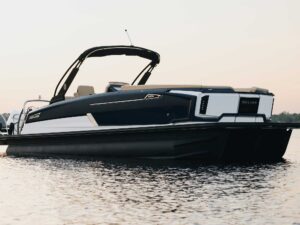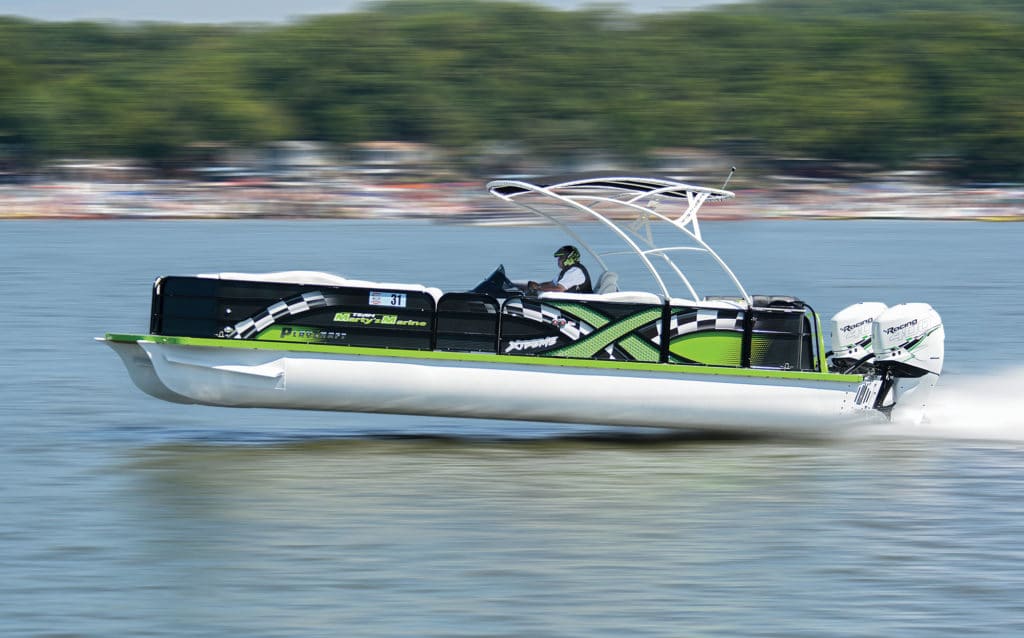
On a sunny day in August 2013, a pontoon enthusiast named Brad Rowland fired up the triple 300 hp Mercury ProMax 300x engines on his 25-foot South Bay tritoon and hammered the throttles. He proceeded to rip down the speed run at the Lake of the Ozarks (LOTO) Shootout at a staggering 114 mph, setting a Guinness World Record for the fastest pontoon boat … ever. Wow.
To get that record, Rowland had to do a ton of setup and modifications to his boat, as well as tweak the engines and propellers. But going fast in a pontoon boat is no longer as uncommon as you’d think. Several builders we interviewed, including Forest River, PlayCraft and Manitou, offer pontoons that can fly.
So, if you’re tired of plodding around the lake in your old-school pontoon with a 30-horse two-stroke, barely able to outrun that afternoon thunderstorm back to your dock, take heed. Today, you can buy an off-the-floor ’toon that will hit 55, 65, even 70 mph. Here’s how they make ’em go fast.
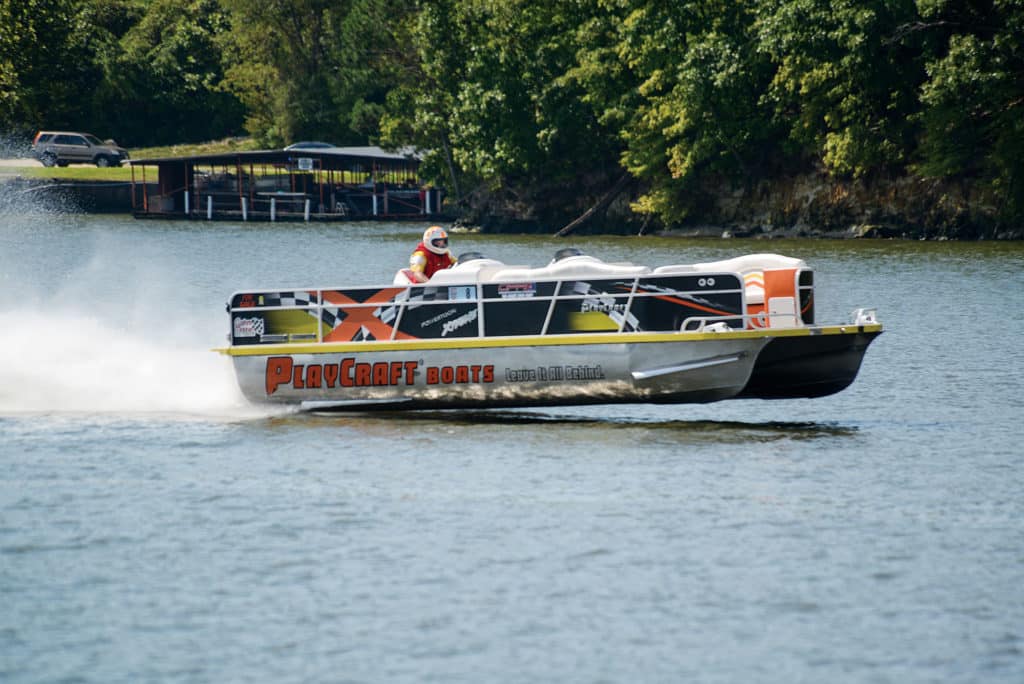
Metal Thunder
Watching a 27-plus-foot pontoon rise up on its sponsons and rocket down the lake at 60-plus mph is, well, surreal. It’s like watching a Boeing 777 lift off. Your first thought is, “How does it fly?” In the case of the pontoon (and the 777, for that matter), it’s a matter of meticulous engineering, testing and plain-old brute power. A big ’toon is long, wide and heavy, and blows through the air and over the water like a brick — so it needs big engines, and years of setup savvy, to get it flying.
Much of the initial groundwork accolades for fast pontoons must certainly go to one man: Jim Dorris, founder and owner of PlayCraft Boats. Dorris has built, set up, won races and set records in just about every kind of vessel imaginable. He started Charger Bass Boats in 1974, and it followed, later in his life, that he began to apply his high-performance boatbuilding knowledge and experience to the pontoon boats he built and sold out of his Missouri factory. This was a personal thing for Dorris; as he got older, he sought the comfort and relaxation of pontooning but didn’t want to give up running fast with the “big boys.”
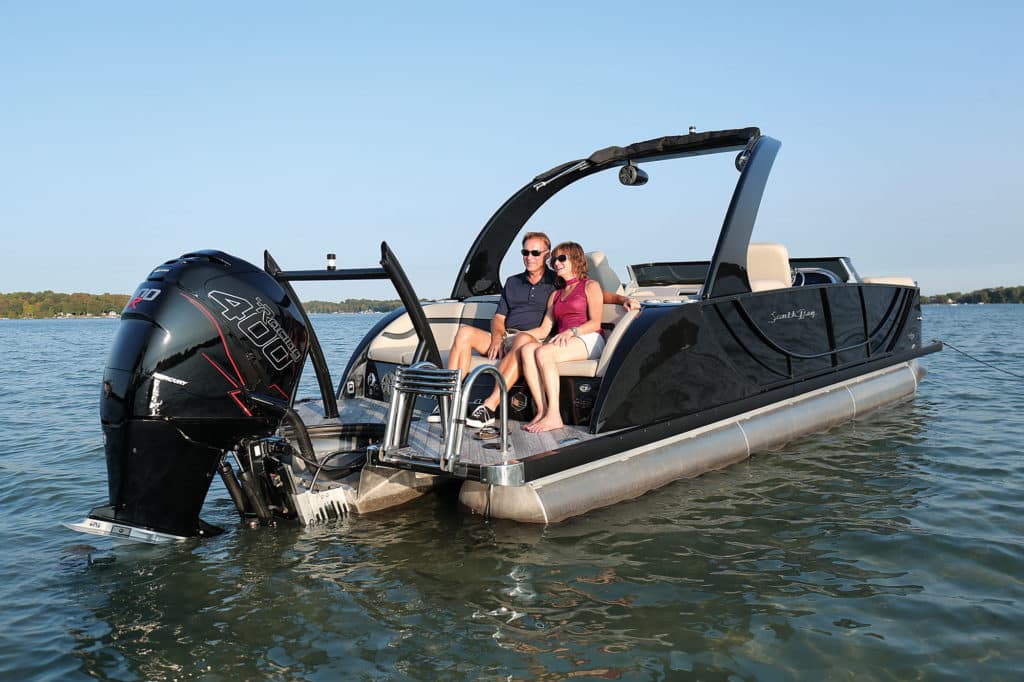
At the now-famous LOTO Shootout back in 1995, Dorris showed up with what he called a Hydro-Toon powered by a small-block 350 Chevy and MerCruiser sterndrive. That was the beginning. Though the 46 mph recorded top speed he attained was unheard of then, it’s positively staid now. Power, design and, of course, speeds accelerated on a steep curve; by 2001, Dorris’ crew logged 81 mph speeds at Mercury’s Lake X with twin Merc 300x outboards. In 2010, PlayCraft was the first to break 100 mph with a pontoon boat.
Dorris and PlayCraft may have been the first to the pontoon speed party, but today the field has become packed with power players. Notables include South Bay and Manitou Pontoons; both companies routinely outfit their highly engineered craft with dual and triple outboards, capable of speeds well into the 60s, 70s and beyond.
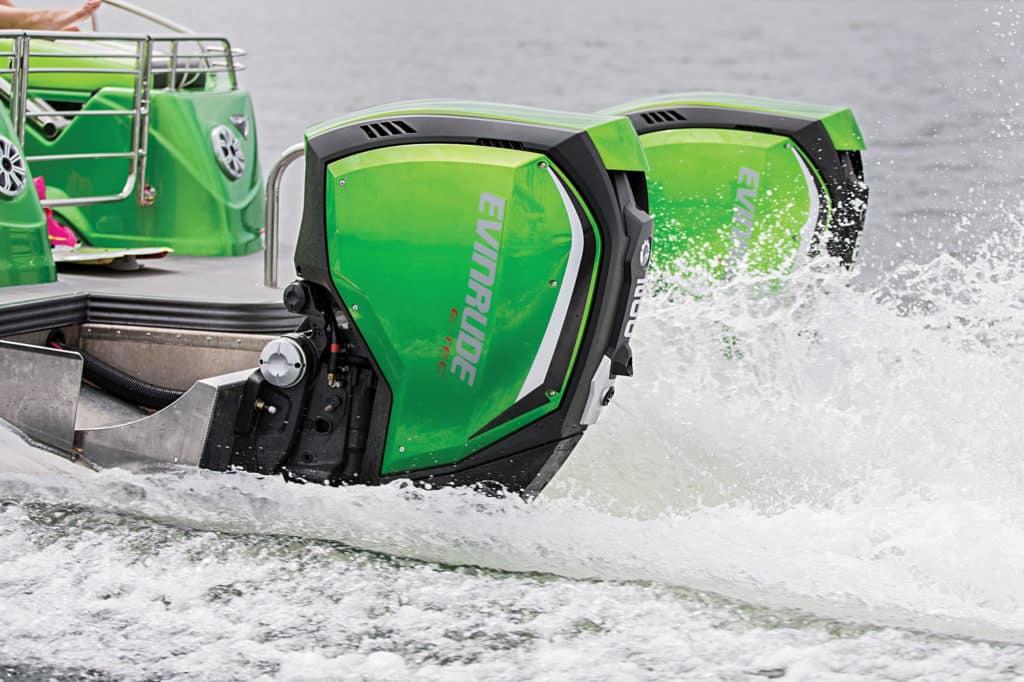
‘Tooning Up
While 100 mph sure is a sexy number, it’s way beyond the capability of 99 percent of the rigs out there. It takes an extremely dedicated effort (not to mention piles of money) to break 100 mph, let alone hit the world-record 114. However, it’s not uncommon to idle up to the sandbar today and see single-engine pontoons capable of 50-plus-mph speeds, and twin-engine rigs capable of 60-plus mph. So, what does it take to build a pontoon capable of achieving these speeds, all the while remaining a factory-warrantable boat that’s easy to operate and doesn’t fall apart after a year or two? To find out, we corralled Dorris, as well as South Bay (Forest River) marketing director John Sweeney and his chief applications engineer, Greg Barsoda. We also spent some time with Manitou’s Greg Van Wagenen, who heads up its marketing and communications department.
South Bay was the first to offer triple-log pontoon configurations on every package, back in 2005. For 2018, the company’s new thing is the V-Lite honeycomb-core decking, which combines light weight and torsional strength. South Bay boats all use 25-inch-diameter tubes with full-length radiused underdeck (“belly”) skinning. This feature cleans up the air traveling under the decks, adding streamlining to an otherwise “dirty” surface. Extruded, radiused lifting strakes are applied to the center tube (on 2.5 series models) and also on the outer tubes, both on the inside (3.0 models) and outside as spray rails (3.0+ models). The inner strakes work together to form a “pad” running surface, much like a performance pleasure V-hull. The strake placement and shape is patterned after racing-tunnel hull and offshore-catamaran designs, so the hulls lift clean from the water with less power, and turn sharply without bobbling or excessive banking. The strakes on the outside also keep spray out and away from the hull. South Bay’s pontoons are pressurized at the factory at 3.5 psi, to keep them from “oil canning” and deforming under extreme loads.
Of course, performance rigging in the form of jack plates and high-performance propellers and gear cases is available on single- and twin-engine pontoons. High-performance assisted hydraulic steering is also a must to keep the larger engines’ torque in check at high speeds.
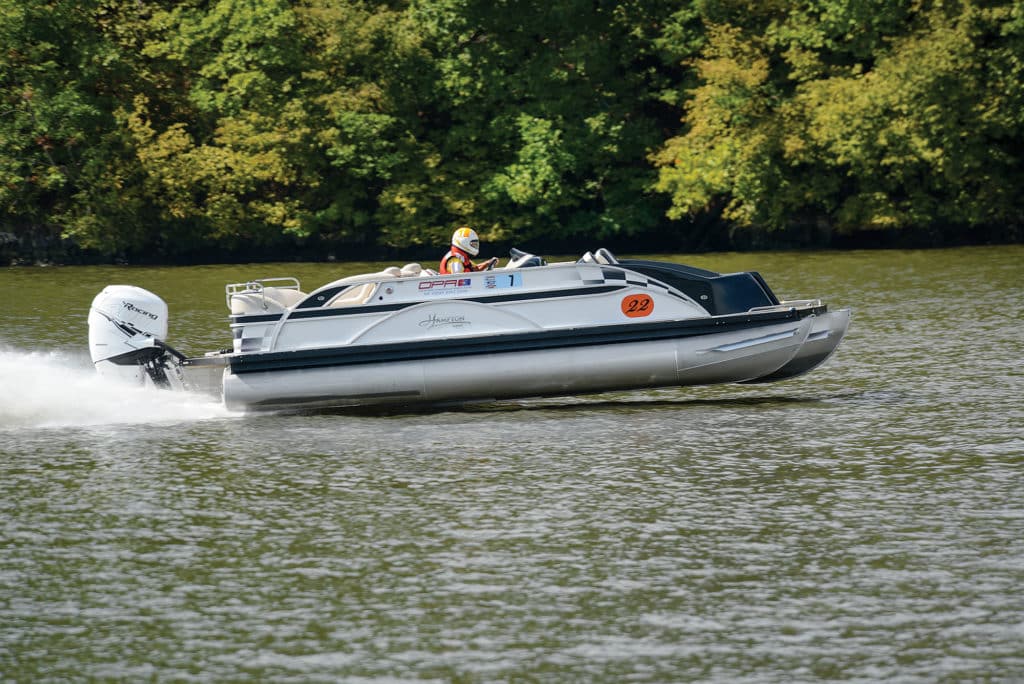
Tubular Innovation
Manitou’s designs are easily recognized, due to the stylized fiberglass deck fencing and seating arrangements — not to mention the gorgeous paint jobs. But it’s underneath where the design, setup and rigging produce the speed and handling characteristics that make these ’toons favorites among the performance and show-off fanatics. Manitou VP of Operations Dave Curtis designed and patented Manitou’s V-Toon hull design, drawing on his extensive snowmobile/motocross racing and performance pleasure-boating background. Manitou employs a larger (27-inch-diameter) center tube between the two smaller 25-inch-diameter outboard tubes. This arrangement effectively presents a V shape to the water, which delivers a ride akin to that of a V-hulled runabout. This design, coupled with strategic placement and shape of the lifting strakes and spray rails, produces flat cornering and strong acceleration, along with enhanced top speed handling. Manitou started rigging twin-engine hulls in 2017 with up to 600 hp. Recent packages with twin Mercury Racing Verado 400R outboards have seen speeds of 73-plus mph with factory stock rigging.
PlayCraft pontoons, even the lower-cost Hampton series models, are all designed with performance in mind. With a single Mercury Racing 400R outboard, the 2685 Hampton hit 78 mph at LOTO in 2017, with Dorris’ wife, Carolyn, handling the driving chores. PlayCraft’s most popular rig is its 27-foot Xtreme with a single Mercury Racing Verado 350 or 400R outboard; speeds with the 350 are in the mid- to high 50s, while the 400R tops 60 mph. The latest popular package is the “10 Wide” (10-foot-wide) hull; at lengths between 30 and 36 feet and fitted with twin 350 Verados, speeds are in the low to mid-60s; with twin 400Rs, these boats run just under 70 mph. PlayCraft employs stepped running surfaces; much like performance offshore racers, the steps relieve water pressure under the sponsons and aerate the water, providing performance gains from 2 to nearly 5 mph (depending on the number, size and shape of the steps) over a conventional nonstepped ’toon. PlayCraft’s pontoons are not round, like many others. They are U-shaped with added lifting strakes to boost speed and offer turning and handling similar to V-bottom hulls.
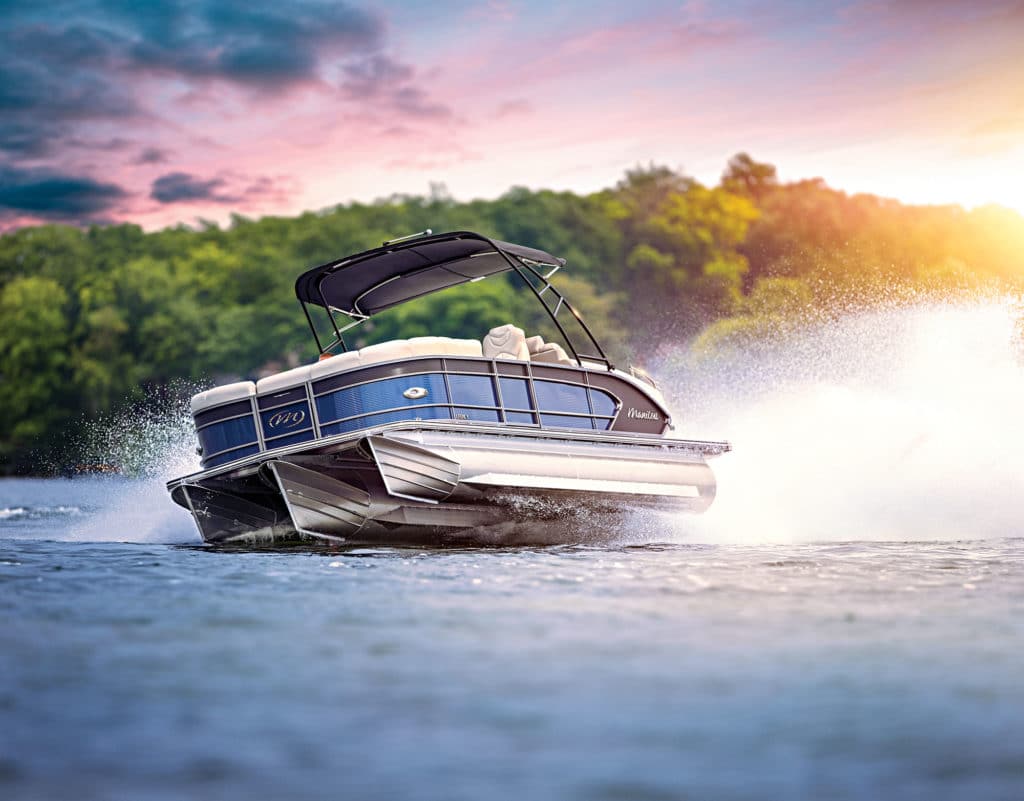
Power Authority
All builders clearly recognize the recent recharging of the horsepower race. Manitou’s Van Wagenen notes that “outboards continue to get larger and more powerful, and at Manitou, we’re working on stronger and better materials and designs to hold up to the increased weight, torque and power, as well as increased potential speeds.”
PlayCraft’s Dorris takes a conservative approach: He notes that while 400, 500 and larger-horsepower engines will become more commonplace in the near future, PlayCraft is testing all boats — and has been for a long time — with full decking, furniture, arches, etc., to ensure that models will perform well in real-world conditions. “If a customer demands an extreme setup, such as triple engines, we will do that only on a much larger — 30-plus-foot-long minimum — hull package,” he adds.
Read Next: [Pontoon Boat Power](https://www.boatingmag.com/boats/pontoon-boat-power-sterndrive-vs-outboard “Pontoon Boat Power”
So, will 100 mph pontoons soon be commonplace at your local lake? “We have pretty much approached the wall as far as speed-enhancing performance designs are concerned,” says South Bay’s Greg Barsoda.
Despite rapidly increasing horsepower and torque from larger engines, boat manufacturers thankfully recognize the need for a safe and sane approach to design for speed, as opposed to chasing every last mile per hour with no respect for what can happen if the design, execution and setup aren’t spot-on. So, get ready to enjoy some speed on the water, in a boat that’s not designed in a “speed at all costs” manner. Finally, here’s some heavy metal that’s music to our ears.

